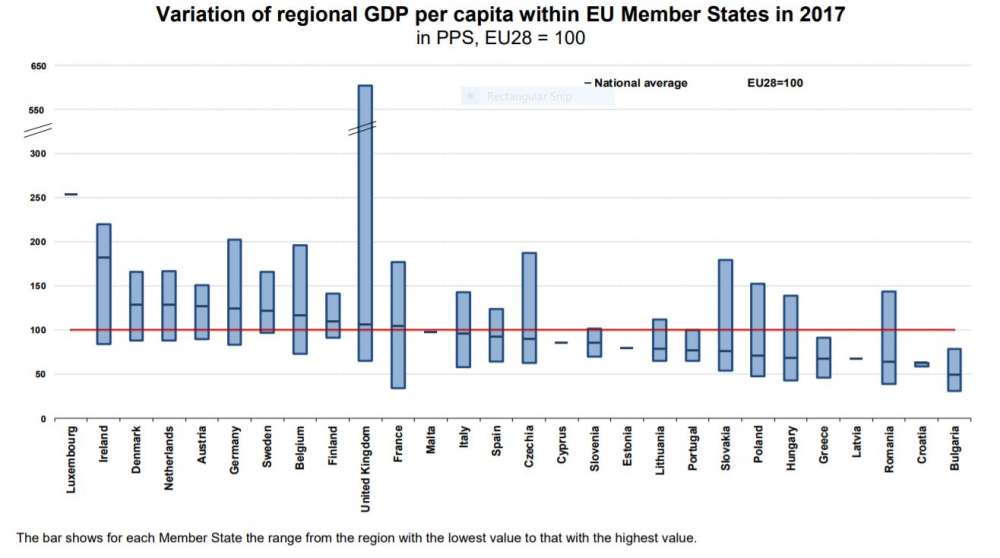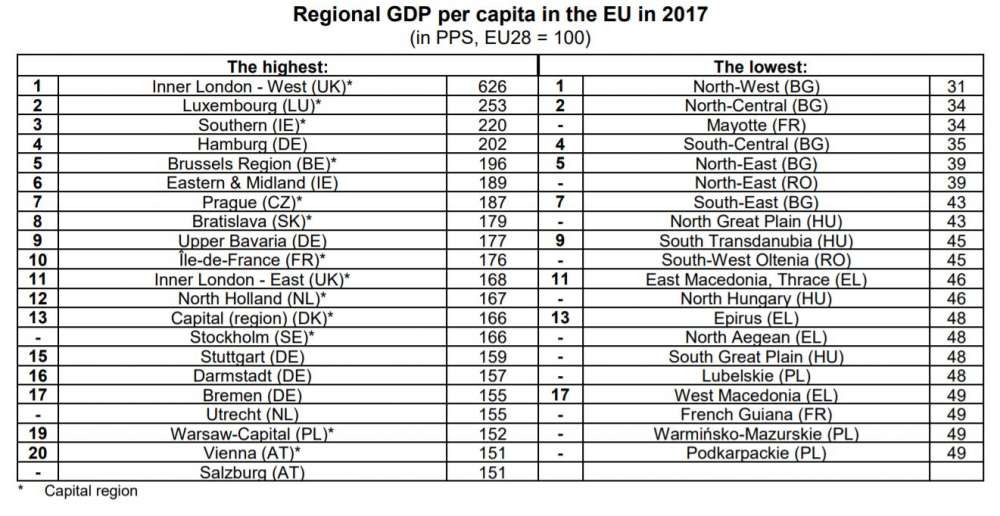The GDP per capita in Purchasing Power Standards (PPS) of Cyprus in 2017 stood at 85% of the EU average, according to Eurostat.
Specifically, in 2017, the GPD per capita in PPS of Cyprus was €25,400, while the EU average was €30,000.
Regional GDP per capita in the EU expressed in terms of purchasing power standards, ranged from 31% of the EU average in the Bulgarian region of North-West (€9,300), to 626% (€188,000) of the average in Inner London – West in the United Kingdom.
According to Eurostat, three quarters of the EU population live in regions where regional GDP per capita is above 75% of the EU average.
As the graph below shows, there is a considerable variation both in the EU and within the Member States.

The leading regions in the ranking of regional GDP per capita in 2017, after Inner London – West in the United Kingdom (626% of the average), were Luxembourg (253%), Southern in Ireland (220%), Hamburg in Germany (202%), Brussels Region in Belgium (196%), Eastern & Midland in Ireland (189%) and Prague in Czechia (187%).
There were 21 regions with GDP per capita 50% or more above the EU average in 2017: five were in Germany, two each in Ireland, Austria, the Netherlands and the United Kingdom and one each in Belgium, Czechia, Denmark, France, Slovakia, Poland and Sweden as well as Luxembourg. Population living in these 21 regions is 52.3 million persons.
In all Member States where there are more than one region at NUTS2 level, the highest GDP per capita is in the capital region, except Berlin in Germany and Lazio in Italy.
After North-West in Bulgaria (31% of the average), the lowest regions in the ranking were Mayotte in France and North-Central in Bulgaria (both 34%) and another region in Bulgaria: South-Central (35%).
Among the 20 regions with GDP per capita below 50% of the EU average, five were in Bulgaria, four each in Greece and Hungary, three in Poland, two each in France and Romania. Population in these 20 regions is 22.9 million persons.
It should be noted, however, that in some regions the GDP per capita figures can be significantly influenced by commuter flows. Net commuter inflows in these regions push up production to a level that could not be achieved by the resident active population on its own. There is a corresponding effect in regions with commuter outflows.

Gross domestic product (GDP) is the total economic output of a country, i.e., the amount of money a country makes. GDP per capita is the total output divided by the number of people in the population, i.e., the average amount of money each person makes.
The two most common ways to measure GDP per capita are nominal and purchasing power parity (abbreviated PPP). Nominal is an attempt at an absolute measure, a sort of immovable standard that remains the same from country to country. It is the original concept of GDP. In contrast, PPP is an attempt at a relative measure, taking factors of each country into consideration in order to put a number on a person’s standard of living within that country.
The purchasing power standard, abbreviated as PPS, is an artificial currency unit. Theoretically, one PPS can buy the same amount of goods and services in each country. However, price differences across borders mean that different amounts of national currency units are needed for the same goods and services depending on the country. PPS are derived by dividing any economic aggregate of a country in national currency by its respective purchasing power parities.
PPS is the technical term used by Eurostat for the common currency in which national accounts aggregates are expressed when adjusted for price level differences using PPPs. Thus, PPPs can be interpreted as the exchange rate of the PPS against the euro.






